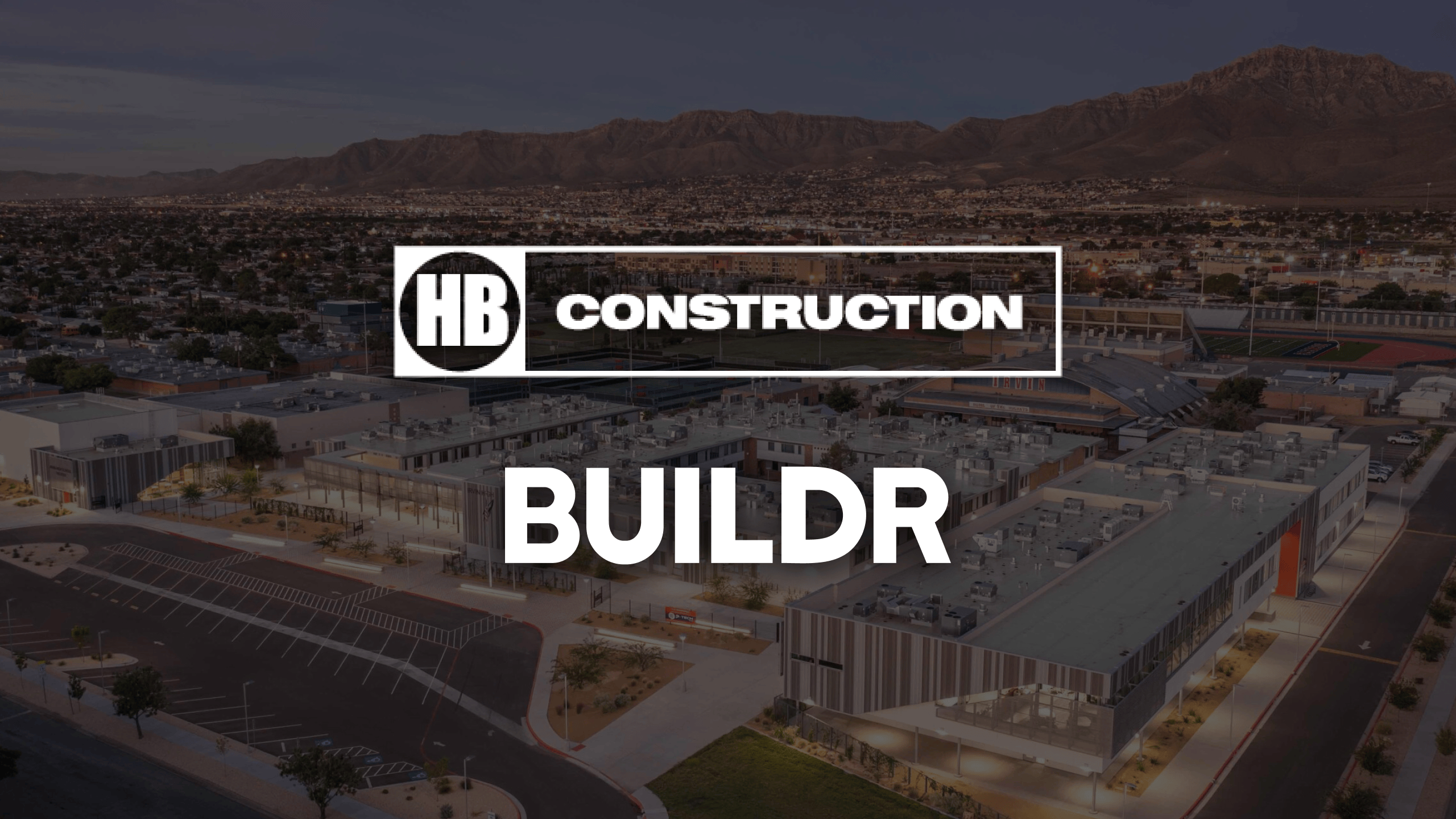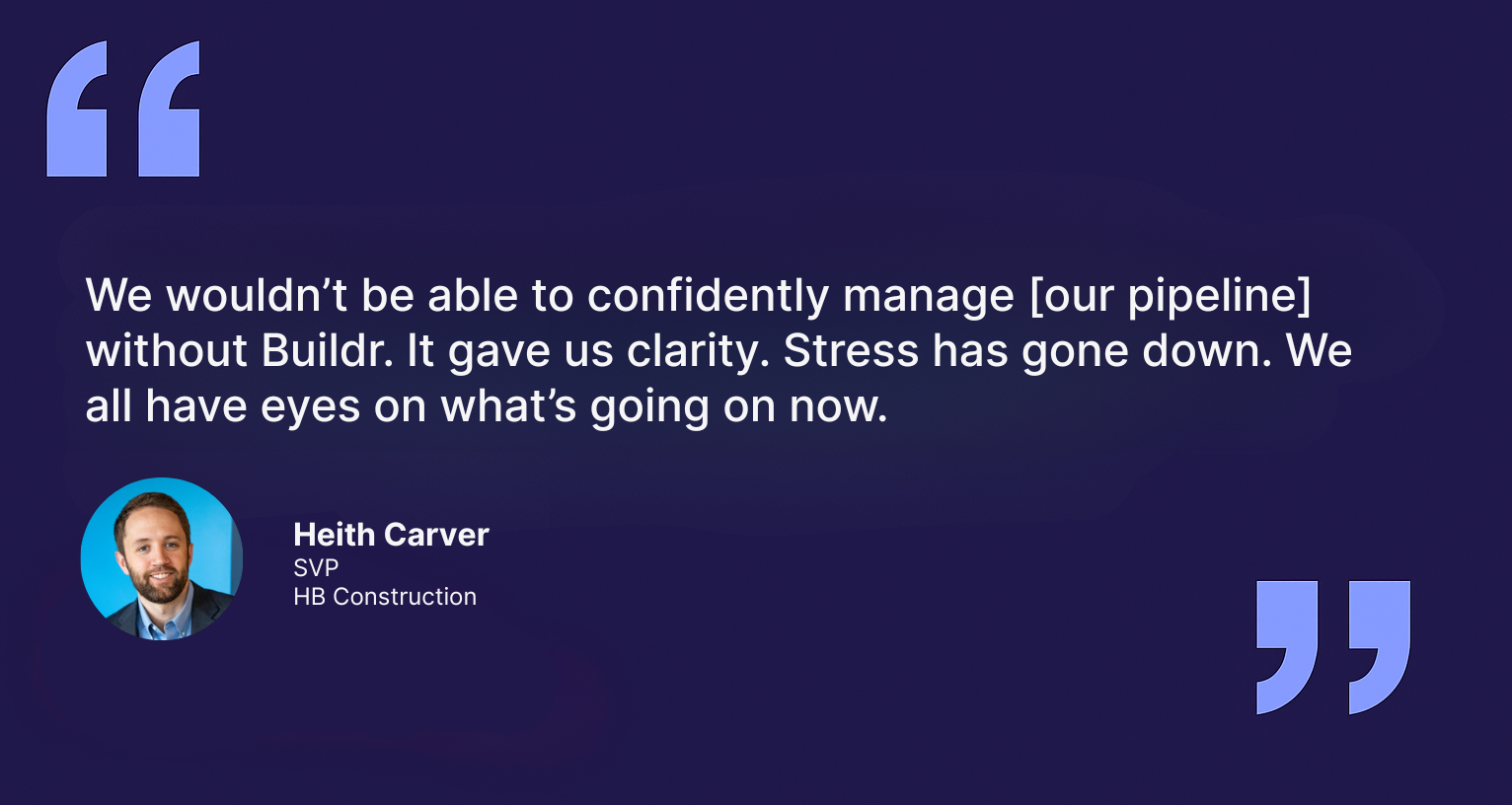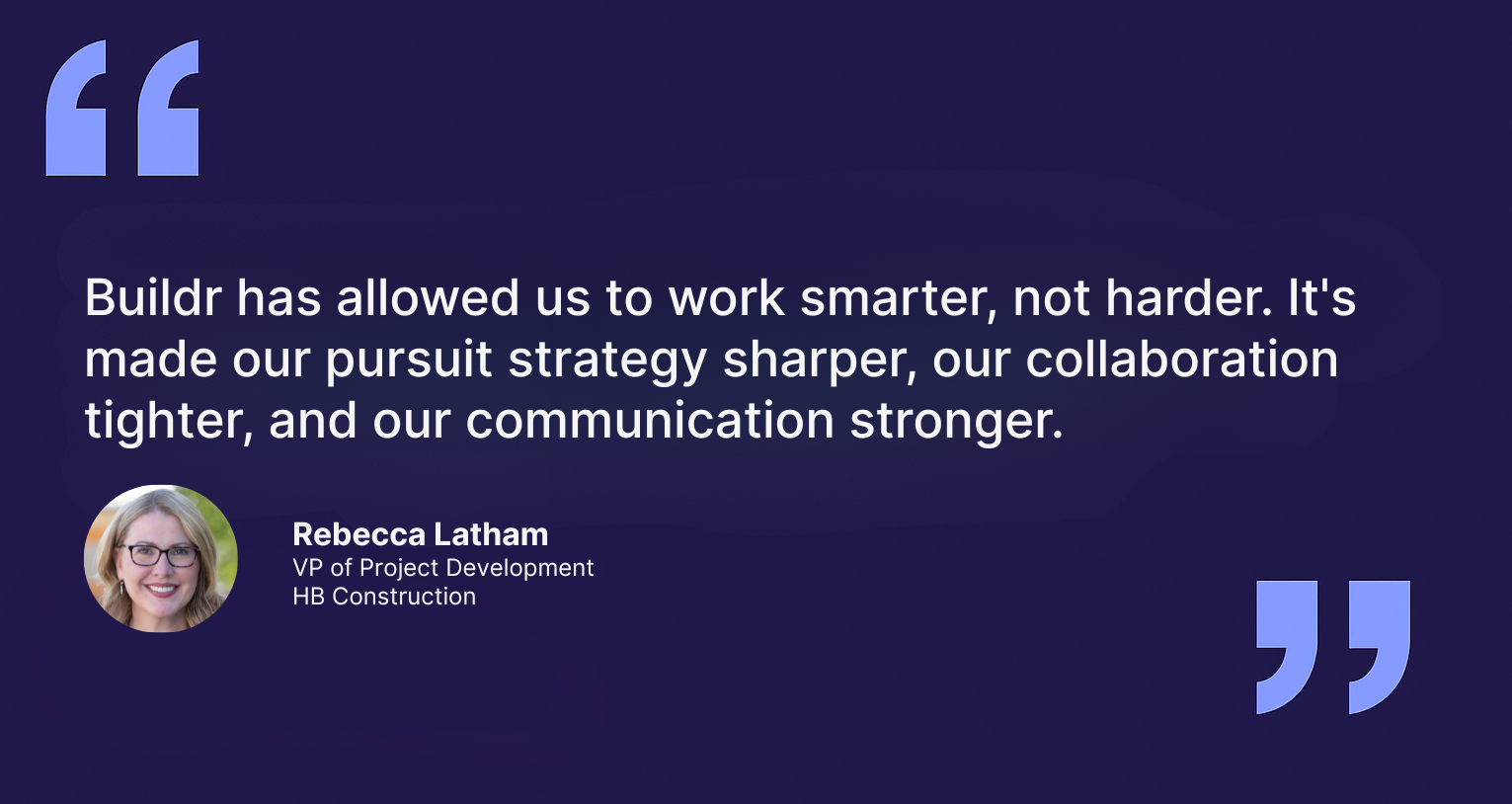How HB Construction Unlocked Collaborative Precon and Pipeline Visibility
The New Mexico general contractor's journey from spreadsheet chaos to strategic clarity.
July 31, 2025
12
min read

HB Construction's background
Founded in 1991 and headquartered in Albuquerque, New Mexico, HB Construction has grown from three people in a job trailer to one of the Southwest's fastest-growing commercial builders. Specializing in Design-Build and Construction Manager at Risk delivery methods, HB serves education, healthcare, government, and private clients across New Mexico and Texas. With a project portfolio that includes everything from award-winning school campuses to critical healthcare facilities, HB has built a reputation for collaborative partnerships and innovative project delivery. The company has been recognized as an ABC Top 250 Performer and Accredited Quality Contractor, and is consistently awarded a Best Place to Work Award by American Business Journals.
Spreadsheets, scattered knowledge, and failed CRM adoptions
When Rebecca Latham joined HB Construction as VP of Project Development, she stepped into a familiar challenge for many general contractors: a tangled web of spreadsheets, scattered knowledge, and failed CRM adoptions.
For years, HB had relied on Excel to track pursuits and projects. "We had a giant spreadsheet with 10 years of project pursuits. No leads, no touchpoints. Everything was just static," Rebecca recalls. "The spreadsheet wasn't going to remind me to follow up, it wasn't going to snooze a lead. We needed a way to sort, simplify, and stay on top of things."
The reality was painful. Critical information lived in individual heads, pursuit decisions were made on gut feel rather than data, and the team often discovered they were chasing the same leads or missing opportunities entirely. "Managing all of that in a spreadsheet… things just got lost. It was completely overwhelming," she said.
Before that, a clunky rollout of another construction-specific CRM had left a bad taste and a leadership team that never fully adopted it.
"It was virtually unusable for anything other than tracking what projects we had," Rebecca said, explaining that the team reverted back to one big spreadsheet. “The spreadsheet had grown so big that it couldn't actually support how we wanted to work."
There was less of a breaking point than a lingering, mounting exhaustion. HB was investing heavily in project development and growth, but their systems were actively working against them. "Without Buildr, we would just miss a project entirely. The RFP would come out, and we'd be forced to make a $20,000 decision without having done any BD. That's what we're solving," Rebecca explained.
Pursuit meetings became exercises in memory recall rather than strategic planning. Team members were duplicating efforts because visibility was nonexistent. And with ambitious revenue targets ahead, they knew the Excel and the “It’s all in my head,” approach would crack under pressure.
The search for a better way: Buildr beats out the competition
HB's software checklist was clear: they needed something that wouldn't require months of training, wouldn't create more administrative burden, and wouldn't end up as another expensive shelf-ware investment like their previous CRM. Burned before, the team was rightfully skeptical.
The speed of implementation was critical. HB couldn't afford a lengthy rollout that would lose momentum or create resistance. When the team began evaluating and vetting 4 precon tools against each other, Buildr wasn't initially ranked highest in flexibility. But that changed quickly.
So what separated Buildr from the pack?
1. Ease-of use
"We signed the contract on a Thursday, had access on Friday, and by Monday we were using it in go/no-go meetings,” said Rebecca.
2. Flexibility
"We were pleasantly surprised," said Heith Carver, SVP at HB Construction. "Buildr was the most out-of-the-box ready for what we needed, and it turned out to be way more customizable than we expected."
3. Construction specificity
"Some of the industry agnostic tools were cheaper, but you get what you pay for," said Rebecca, citing the expense of third party engineering support.
4. Built-in workforce planning
"We looked at industry-leading workforce software but it was just a glorified spreadsheet. The cost didn't justify scheduling that wasn't even tied to project data like Buildr is," said Travis Coker, HB Construction's COO.
5. Unlimited seats
"That's huge. If you have to ask, 'Will this user cost me more?' every time, it's impossible to scale," said Travis. "With Buildr, that's not an obstacle."
.png)
One precon headquarters, one company primed for growth
Adoption spread quickly. Rebecca took the lead on early-stage leads and go/no-go strategy, Heith focused on pipeline and coordinating deliverables across estimating and marketing, and Travis handled scheduling manpower across projects and pursuits.
The transformation was immediate and measurable. What used to be guesswork became precision tracking. "I'm more on the pursuit project management side—staying on top of deadlines and making sure we're coordinated," Heith said. “With upwards of $400 million in active pursuits, we wouldn’t have been able to manage that confidently without Buildr."
Before Buildr, HB was essentially flying blind. They had no clear picture of their true pipeline health, no way to prioritize pursuits strategically, and no confidence in their pursuit forecasting. "I don't think we had a totally accurate view of what our pipeline even was," Heith said. "Buildr gave us clarity. Stress has gone down. We all have eyes on what's going on now.”
The psychological shift was as important as the operational one. Teams went from feeling overwhelmed and reactive to feeling in control and strategic.
From gut feel to data-backed pursuits
The old way was unsustainable: pursuit decisions made in conference rooms based on memory and educated guesses from a massive spreadsheet. Win rates were inconsistent, and the team often found themselves chasing low-probability opportunities while missing higher-value prospects with no understanding of lost job patterns.
HB has now formalized their pursuit strategy with Buildr at the center. "We've built in a quality control process," Heith explained. "There's a pre-go/no-go score and a pursuit health metric that helps us track whether we're getting the right leads in the right markets."
This systematic approach replaced the anxiety of unclear priorities with confidence in strategic focus. Instead of saying yes to anything and stretching resources thin, HB could now make informed decisions about where to invest their pursuit energy. "I was building a scoring spreadsheet on my own for pre–go/no-go, and before I finished it, the leads go/no-go tool just appeared in Buildr. Like, boom, there it is," Rebecca said, citing her appreciation of the product team's constant new feature drops.
Rebecca added that it's not just about qualification, it's about access to collective intelligence: "Now everyone knows what I know. Every owner conversation, every architect coffee, it's all captured and accessible to the whole team which saves so much catch-up time and energy."

From tribal knowledge to shared visibility
The "tribal knowledge" problem was killing HB's efficiency. Critical client insights died when team members were OOO. Relationship histories were locked in individual memories. New team members had no way to get up to speed quickly on key accounts.
Before Buildr, insights were stuck in heads, inboxes, or hallway conversations. Now, they're accessible to all.
"The habit to get into is entering information," said Heith. "A lot of it was conversation-based—tribal knowledge. Rebecca and I are huge on getting that into Buildr so we can all leverage it."
The culture shift was intentional and immediate. To drive behavior change, HB didn't wait for perfection, they built towards it. "We hold a weekly call on all our pursuits," Heith said. "We just sit there entering things as people talk. You can't rely on one or two people doing all the work—it's about collective access."
This approach eliminated the bottleneck of information hoarding and created true team intelligence where everyone could contribute to and benefit from the collective knowledge.

Adoption made (really) easy
Previous software rollouts at HB had been painful exercises in change management. Training sessions, resistance, stagnant adoption, and eventually, abandonment. The team was understandably wary of another "transformative" software implementation.
Rollouts often spark resistance. Not here.
"Buildr made adoption easy," Heith said. "The intuitiveness of the software, being able to change views on the fly, and how responsive you've been to our feedback, it all helped. If we asked [other leading construction software vendors] to change something, we'd get laughed out of the room. With Buildr, we've seen feature requests implemented within the month. It feels like a real partnership."
The responsiveness was game-changing. "Every week there are new features. I didn't even know we needed them, but there they are," Rebecca added. "I couldn't sort leads by alphabetical order or projected start date last week, and now I can. With Buildr, it actually shows up." Instead of feeling like they were stuck with rigid software that didn't fit their workflow, HB felt like they had a technology partner that evolved with their needs.
Unlimited users didn't hurt either. This removed the artificial barrier that often kills CRM adoption, the fear of adding users due to cost constraints. HB's prior CRM, and most CRMs, feature per-seat model pricing which often kills true collaboration.

"The bridge between precon, pursuits, and operations"
Before Buildr, HB's departments operated in silos. Business development pursued leads without full visibility into operations capacity. Marketing created proposals without understanding pursuit priority. Operations planned projects without insight into the broader pipeline. Travis Coker managed workforce planning through a spreadsheet that was error-prone and accessible to only a few people due to discretion concerns.
"We had this project-by-project spreadsheet, trying to manage and duplicate lists," Travis explained. "It's a monster to try to keep current and maintain. The more tabs you have and the more formulas you have in Excel, the more it has a tendency to glitch."
Buildr didn't just serve business development, it helped unify the company. The integration between CRM and workforce management became a game-changer. HB now uses Buildr for:
- Project development & BD: lead tracking, relationship management, pursuit scoring
- Proposal & marketing coordination: resume building, team assignments, deliverables
- Operations & field planning: workforce scheduling and long-term staff visibility
- Executive strategy: real-time dashboards, forecasting, and go/no-go decision-making
The workforce planning capabilities transformed how HB makes strategic decisions. "It allows us to be the most informed that we can be at any given time when making go/no-go decisions," Travis said. "Rather than having a feeling or an idea of who might be available, I can go look at the schedule of assignments and have that information right at my fingertips for making better decisions."
This visibility also enabled operational efficiency gains that directly impacted the bottom line. "We had this healthcare project, and I noticed we had three project engineers assigned to it," Travis recalled. "We were through our submittal phase at that point. So I asked the PM: 'Do you still need these three people?' We reassigned one to another project where he could be better utilized. It's a double-edged sword. You're saving that salary cost while boosting the project that needs help."
"Buildr has been a bridge between preconstruction, pursuits, and operations," Heith said. "Especially with the staff management tools. It's changed how we plan." This cross-functional visibility eliminated the disconnect between what was being pursued and what could actually be delivered, creating a more strategic and realistic approach to growth. "Now we can bring project teams into the bidding process early because we already know who's available. They're walking into projects with full context," Rebecca explained.
The cultural impact was significant too. Before Buildr, field staff would worry about upcoming assignments, but leadership could only provide vague reassurances. Now, Travis explained, "Our operational managers have visibility on the entirety of the pipeline. When someone asks about their next assignment, they can say, 'We're bidding x projects right now and waiting on another y.’ It helps calm down the operational leadership level, which then helps calm down the other tiers in the company."
The time savings were measurable. "It probably saves me at least a couple hours a week personally," Travis noted. "But the reality is, I don't know the full impact because a lot of times information just wouldn't get done before, whereas in here it's done and done right. You can't actively manage what you can't see very well."
Results
- $400M+ in active pursuits, tracked with confidence
- Improved pursuit quality with data-driven go/no-go and lead health scoring
- Cross-functional alignment from BD to ops to execs, ending departmental silos
- Tribal knowledge eliminated via centralized data entry and access
- ~20 active users across teams
- Higher win rates through strategic pursuit focus and better qualification
- Reduced administrative burden with higher pipeline visibility
- Accurate forecasting replacing guesswork
- Operational efficiency gains through project data-fueled workforce planning
- Unmatched level of employee communication
Final verdict
"Buildr has allowed us to work smarter, not harder," Rebecca said. "It's made our pursuit strategy sharper, our collaboration tighter, and our communication stronger."
The transformation went beyond software. It fundamentally changed how HB approaches growth, from reactive to strategic, from individual to collaborative, from chaotic to confident. "I am just a true believer in Buildr," she said. "I'm shocked at how few people in this industry aren't using a CRM, let alone a centralized preconstruction platform. When I meet someone who's still using a spreadsheet, I'm like, 'Bro, there's a better way. Let me enhance your quality of life in about six seconds.'"
"It's a great, easy-to-use preconstruction platform that's so much more than a CRM," Heith added. "You can do a lot more with it, and the product team actually listens to feedback and improves the product. That's rare."
For a company that had been burned by software promises before, finding a true technology partner made all the difference. “I’ll happily keep referring GCs as long as you guys just keep doing your thing," Rebecca concluded.
Travis offered this perspective for other industry leaders: "If there's any part of your organization that is not tooled up and allowing you to be the most efficient and effective that you can be, you are losing ground to your competitors, period. There's less time, less money, and fewer resources than there ever has been. The workforce integration with the CRM data is a huge part of the advantage. Having that direct link between what your pursuits are and your workforce planning decisions."

Stay in the loop.
Get the latest expert insights, tips, and updates on preconstruction, business development, estimating, and more — delivered straight to your inbox.
Stay in the loop.
Get the latest expert insights, tips, and updates on preconstruction, business development, estimating, and more — delivered straight to your inbox.


